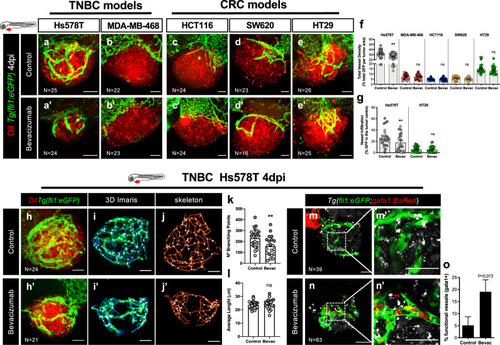|
Bevacizumab reduces angiogenesis and promotes vessel normalization.Human cancer cell lines (Hs578T, MDA-MB-468, HCT116, SW620 or HT29) were fluorescently labeled with DiI (in red) and injected into the PVS of 2 dpf Tg(fli1:eGFP) zebrafish larvae. Zebrafish xenografts were treated in vivo with bevacizumab and compared with untreated controls. At 4 dpi, zebrafish xenografts vasculature was imaged by confocal microscopy (max Z-projections) (a–e’). Total vessel density (f, **P = 0.0023) and vessel infiltration (g, **P = 0.0027) were quantified. Filament analysis was performed in Hs578T tumor-related vasculature. Hs578T xenografts confocal images of untreated and Bevacizumab-treated (h, h’) were used to perform 3D projections using Imaris (i–i’) and skeletonized images on ImageJ (j–j’). Number of branching points (k, **P = 0.007) and average vessel length (l, P = 0.61) were quantified by filament analysis. To analyze the functionality of Hs578T tumor-related vessels, tumor cells were labeled with DeepRed (in gray) to generate xenografts in Tg(fli1:eGFP; gata1:DsRed) zebrafish larvae. Xenografts were treated in vivo with bevacizumab and compared with untreated controls. At 4 dpi, zebrafish xenografts were mounted in low melting agarose to be visualized by live-imaging confocal microscopy (m–n’). The percentage of xenografts with erythrocytes inside blood vessels was quantified (o). All outcomes are expressed as AVG ± SEM. The number of xenografts analyzed are indicated in the representative images and each dot represents one zebrafish xenograft. Results are from 2 independent experiments, which are highlighted in different colors corresponding to each individual experiment. Statistical analysis was performed using an unpaired t-test or Fisher’s exact test. Statistical results: (ns) > 0.05, *P ≤ 0.05, **P ≤ 0.01, ***P ≤ 0.001, ****P ≤ 0.0001. Scale bars represent 50 μm. All images are anterior to the left, posterior to right, dorsal up and ventral down.
|

